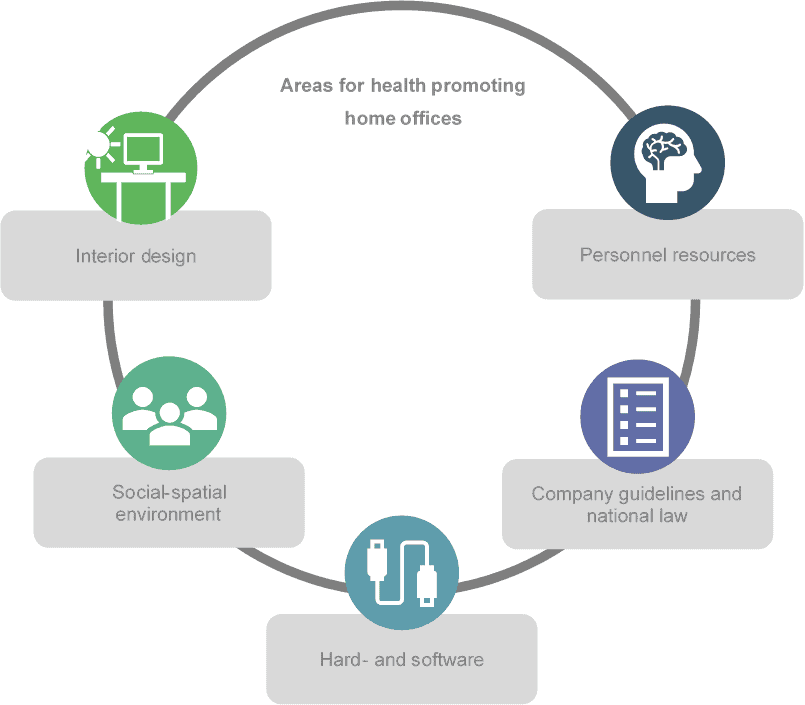As working from home becomes the norm for many, how can employees be supported to develop health-promoting home offices? Experts from Austria have created a handbook, explained here.
Written by Kathrin Hofer-Fischanger and Gert Lang
Is telework health promoting?
Supportive technologies for telework have been available for years, although awareness and necessity for this kind of working is now higher than ever before. The coronavirus pandemic has hit Europe hard, but lockdown measures to tackle the spread of the virus have boosted teleworking.
Many employees now work from home and gain various benefits doing so. They might save time otherwise spent on commuting to work and enjoy quieter working environments provided they are home alone or have a separate room for working. However, some working conditions at home might not be health promoting. For instance, working at the kitchen table often means sitting in a less than ideal ergonomic position. It can also mean there is little separation between work and private life.
How to best support employees during telework?
Based on knowledge about the barriers and challenges to health during teleworking, Kathrin Hofer-Fischanger, Senior Lecturer at FH JOANNEUM – University of Applied Sciences, and her student Magdalena Kappel, in 2018 decided to work on this topic for a Master’s thesis. The main aim of the thesis was to support employees in implementing health promotion measures during telework. This knowledge was then used to create an easy-to-read handbook for health promotion in home offices, including a literature background and practical tips and a checklist for starting telework.
How the handbook was developed
The development of the handbook started with a review of the available literature. Six Austrian experts in the fields of workplace health promotion, architecture, environmental psychology and labour law contributed their knowledge and experience within a modified delphi-process. Some of these experts had been teleworking for years. In addition, the Austrian Health Promotion Fund was part of the development of the handbook, sharing its expertise on health promotion measures.
Five areas for health promoting home offices

1) Company guidelines in accordance with the national laws
Before employees start with telework, some legal aspects need to be arranged with the company, such as the legal framework for teleworking, agreements on attendance at work, meeting times or break regulations, communication features, and rules.
2) Interior design
Besides an ergonomically suitable desktop and seat, aspects concerning lightning, room temperature and air quality need to be considered. Plants and natural or personnel elements could strengthen a “feel good climate” at home.
3) Hardware and software equipment
Not every employee can use his personnel devices for teleworking. Employers and employees need to agree on the use of important working equipment (hard and software) at home and should not forget to make agreements on data privacy.
4) Personnel resources and support
Whether it is possible to be productive while working from home depends largely on individual knowledge and competences. To promote health and ensure productivity, employees should be able to focus and have a good self-organisation and time management skills. For example, it can be helpful to set daily goals, decide on work packages, and take enough breaks.
5) Social-spatial environment
Although, interruptions from colleagues are less likely to occur when working from home, there can be many other disturbing or distracting circumstances. Think for example of family members who are at home as well, the washing machine, waiting housework or a neighbour’s lawn mower. It is advisable to reduce any disturbing factors or noises and to have spatial separation of work and life in order to be productive and focused and to avoid conflicts with your partner and family.
This year, FH JOANNEUM – University of Applied Sciences and the Austrian Health Promotion Fund will continue their cooperation and work on this topic together. Against the background of the current COVID-19 pandemic, an applied research project with qualitative and quantitative methods is being conducted. The aim is to evaluate the applicability of the handbook in practice and to identify additional needs for health promotion during telework in companies, such as training programmes. The handbook will be extended with real-life experiences and with insights on how home offices can be designed to promote the health of employees.
The Handbook for health promoting home offices (in German) can be downloaded here.


